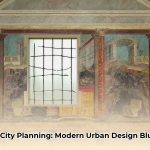Have you ever peered beyond the grandeur of the Roman Forum or the echoing halls of a bathhouse to ponder the most private spaces of ancient Rome? The cubiculum – their equivalent of a bedroom – was far more than just a place to sleep. It served as a microcosm of Roman society, reflecting wealth, status, personal habits, and an intricate social fabric. Let us step behind the closed doors of these intimate chambers to uncover the daily rhythms, design secrets, and stark social contrasts that defined private life in one of history’s greatest empires.
Learn more about Roman bedding practices that influenced comfort.
The Cubiculum Unveiled: A Private Sanctuary in the Roman Home
A cubiculum was a multifaceted space, its character varying profoundly from the bustling domus of a patrician to the cramped confines of an insulae apartment. These rooms, typically modest in size, offered a rare glimpse into personal routines and cultural values, often leading directly from the atrium or, in later periods, adjacent to the peristyle. They were sanctuaries for quiet contemplation, intimate conversations, and even clandestine meetings, shaping destinies within their humble confines.
Consider the morning routine of a prosperous Roman citizen. The first whispers of dawn would filter into the cubiculum, not through glass, but through thin, oiled linen or shutters covering small window openings, if a window was present at all. The occupant would stir on their lectus, or bed frame, which might be an ornate structure of bronze or bone or a simple wooden platform, its mattress plump with feathers or humble straw. A chill might linger in the air, especially during winter months, but in wealthy homes, the ingenious Roman hypocaust system, a form of underfloor heating, could radiate warmth upwards, a testament to sophisticated engineering.
Throughout the day, the cubiculum transcended its primary role as a sleeping area. It could transform into a quiet study for private reading, a personal workspace, or even a sacred space for religious observance. Many affluent homes featured a small household shrine, a lararium, within the cubiculum to honor the family’s guardian deities, underscoring the room’s private and often spiritual significance. The private nature of the cubiculum made it a preferred venue for quiet discussions, the reception of important guests, and even the display of highly prized works of art. Ancient accounts even reveal its use for illicit contemplation and personal fasting.
As dusk descended, the cubiculum would prepare for the night. Oil lamps, the primary source of artificial light, cast dancing shadows across the room, and the sounds of the city gradually receded. Before retiring, it was common for Romans to offer a silent prayer to Somnus, the god of sleep, seeking peaceful rest. This evening ritual highlights the deeply ingrained spiritual aspect of Roman daily life, extending even into their most private moments.
The Art of Roman Comfort: Beds, Furnishings, and Aesthetics
The Roman cubiculum, while often spartan by modern standards, showcased an intriguing blend of practicality and status through its furnishings and décor. The focus was less on plush comfort and more on costly materials, fine workmanship, and artistic forms, particularly for the wealthy.
The lectus, or bed, stood as the central and most significant piece of furniture, often serving as a powerful declaration of social standing. For the less fortunate, sleeping solutions were basic: a simple straw mat or a bedroll laid directly on a masonry shelf built into the wall or even on the floor. In contrast, the affluent enjoyed elaborate bed frames, the lectus cubicularis, crafted from costly bronze, precious ivory, or rare exotic woods like oak, maple, terebinth, or even lecti pavonini – exotic woods whose polished surfaces shimmered with multiple colors like peacock feathers. These frames were frequently fitted with interwoven straps serving as springs, supporting mattresses generously filled with wool, down, or swan feathers, and topped with soft pillows (culcita or cervical). The highest quality mattresses, often described by Pliny, were covered with two blankets, typically sheep or goat skins, and a rich counterpane (lodix) or multicolored damask quilt (polymitum). Climbing into such an elevated bed often required a scamnum or footstool, underscoring its grandeur. Married couples might share a lectus genialis, while dining rooms housed longer couches, triclinia, for three people or even six-person couches for grand displays of wealth.
Beyond the central bed, the cubiculum contained other essential furnishings. Robust wooden chests (arcae), often reinforced with bronze or leather coverings, were crucial for storing clothes and linens, and for the safe keeping of important papers, money, and jewelry. The Romans are even credited with inventing wardrobes (armaria), tall wooden cabinets with two perforated doors, used primarily to protect or contain precious, delicate, or utilitarian objects rather than clothes. Small tables (mensae), often tripods, with marble or worked wood tops, and personal safes, heavy bronze cases with studs, keys, and bolts, also found their place within these rooms, sometimes even featuring secret compartments.
Walls were frequently adorned with vibrant frescoes, depicting everything from serene landscapes and gardens to mythological scenes, colonnades, or even trompe l’oeil faux marble, creating an illusion of spaciousness and liveliness within the often windowless rooms. Mosaic floors, usually composed of intricate white tesserae with simple geometric ornaments, completed the room’s ambiance. Mirrors, though not hanging on walls as in modern times, were commonplace and believed to ward off evil spirits while also providing light. Tapestries were often hung to limit the movement of insects, and mattresses and coverings were decorated with pleasing floral images.
Ingenious Solutions: Roman Heating and Hygiene
Considering the variable Mediterranean climate, Romans devised remarkably advanced solutions for domestic comfort, particularly within their private quarters. Their ingenuity extended beyond mere furnishings to sophisticated environmental controls.
The pinnacle of Roman heating technology was the hypocaust system, a sophisticated form of central heating primarily found in public bathhouses (thermae) and the sprawling residences of the wealthy elite. This system operated using a furnace (praefurnium) that burned wood. The hot air generated would circulate through a network of spaces created by raised pillars called suspensurae beneath the floor. From there, the warmth would rise through vertical flues built into the walls, effectively heating the entire room. While revolutionary, the hypocaust was a luxury, requiring a continuous supply of wood and dedicated slave labor, thus serving as a clear marker of social standing.
For those of more modest means, heating relied on simpler, less efficient methods such as portable braziers or open fires. These alternatives, however, carried inherent risks, including fire hazards and the dangers of carbon monoxide poisoning.
The Romans also displayed an early understanding of passive solar heating. Many homes and cubicula were designed with south-facing windows to maximize solar heat gain during the day. This strategic architectural placement allowed them to naturally warm living spaces, reducing the need for constant artificial heating.
Beyond warmth, Roman bedrooms also reflected an awareness of hygiene. Mattress fillings, such as leaves found in Herculaneum, were chosen for their potential antiparasitic action. Beds placed on slatted frames ensured air circulation, preventing mattresses from becoming overly hot and mitigating mite infestations. Beeswax sealants were used to block bedbugs and other insects from permeating bed frames. While public baths played a significant role in overall hygiene, the design of the cubiculum itself contributed to a cleaner sleeping environment.
Social Reflection: Wealth, Poverty, and the Cubiculum’s Tale
The very nature of a cubiculum served as a powerful testament to an individual’s place in Roman society. From the grand domus to the humble insulae, the differences in private spaces revealed profound disparities in comfort, privacy, and overall quality of life.
For the less fortunate, life was undeniably cramped. A single room, often a cenaculum (apartment unit), typically served every domestic purpose: cooking, living, and sleeping. Such multi-purpose, often-shared environments offered a severe lack of privacy. In stark contrast, wealthy Romans inhabited extensive domus with multiple cubicula surrounding a central atrium. Pliny the Younger, for instance, described several distinct cubicula in his villas, some specifically designated as libraries, others designed with hypocausts, typically measuring around 2.5 meters by 3 meters. This starkly demonstrates that space, like so many aspects of Roman life, was a luxury enjoyed by only a select few.
The concept of a “bedroom” itself varied dramatically. Wealthy Romans could maintain cubicula diurna for daytime siestas, often situated in cooler parts of the peristyle, and cubicula nocturna or dormitoria for overnight sleep, strategically oriented to catch the morning sun. Such specialized functions were simply impossible for the poor, whose singular room had to adapt to all hours and needs.
Perhaps the most poignant contrast in Roman sleeping arrangements is found in the conditions endured by enslaved individuals. They typically slept on simple straw mats laid directly on the floor, often in high-traffic areas such as kitchens, hallways, or attics within their owners’ homes. Privacy was virtually nonexistent, and their living conditions were frequently severe, highlighting the extreme end of Roman social stratification.
| Feature | Wealthy Roman (Domus) | Poor Roman (Insulae) | Enslaved Individual (within Domus or elsewhere) |
|---|---|---|---|
| Space & Privacy | Dedicated, multiple private rooms, specialized functions | Single, multi-purpose, often shared room (cenaculum) | Minimal to none; often slept in common areas |
| Bed Type | Ornate lectus (wood, bronze, ivory), feather/wool mattress | Simple wooden frame with woven support or straw mat/terracotta platform | Simple straw mat directly on floor |
| Comfort Level | High; soft mattresses, potentially heated | Low; hard surfaces, minimal padding | Minimal; uncomfortable, exposed |
| Decoration | Elaborate frescoes, mosaics, integrated lararium | Bare walls, minimal or no adornment | None |
| Heating/Light | Hypocaust system, multiple oil lamps, strategic windows | Limited; simple, smoky oil lamps, no hypocaust | Basic, often reliant on hearths or communal light |
| Furnishings | Chests, wardrobes, tables, safes, personal libraries | Very few personal items, basic storage | Few to no personal possessions |
Beyond the Bed: Practices and Innovations
Roman sleeping habits extended beyond the physical attributes of the cubiculum. Interesting cultural practices further define their approach to rest and intimacy. The Romans, unusually for their time, did not demand couples to sleep in separate beds. Instead, sleeping together as a couple was highly regarded, seen as a status symbol, which facilitated the sharing of body heat, enhanced intimacy, and was even believed to ward off “night-terrors.” Nudity in the bedroom was also embraced, viewed as a sign of comfort and, for the elite, indicative of wealth and power.
When travelling, Romans often utilized portable beds. The triclinia were three-sided portable beds that could be easily folded and carried, offering a comfortable solution during journeys or visits to friends. The curule beds were similar but featured a single mattress, lightweight and highly portable, often used by soldiers on the move. For more permanent, robust solutions in military camps or humble settings, the tramez, a single bed on a wooden or marble base, was common.
Regarding illumination, while bedtimes were often dictated by the sun’s patterns, Romans were early experimenters with artificial, or “circadian,” lighting. Fire lamps and specially made oil lamps, hung from hooks or placed on stands (candelabra), allowed families to extend their days, making lives less limited by nightfall and providing light without the interruption of insect swarms.
Archaeological discoveries have greatly enriched our understanding of Roman bedrooms. Paintings often depicted cupids, gods, prophecies, and various scenes, alongside vibrant colors thought to offer protection. Additionally, useful everyday objects like cushions and shoes were popular decorative motifs. Recent finds, such as a 2,000-year-old Roman funerary bed in London and burnt beds in Pompeii, provide tangible evidence of these elaborate structures and their role in both life and death.
The Enduring Legacy of Roman Bedrooms
The cubiculum, in its various forms, offers far more than a mere glimpse into Roman sleeping habits. It provides a profound insight into a society rigidly stratified by wealth, a culture that masterfully balanced practicality with luxury, and the sharp, undeniable contrasts in daily life that defined the Roman world. From sophisticated heating systems to the symbolic power of a feather-filled mattress, these private spaces illuminate the ingenuity and social complexities of ancient Rome.
Many of their principles and materials still resonate today. The concept of slatted bed frames for aeration, the use of natural fillings like wool and feathers, and the importance of bedding for comfort and insulation all echo Roman foresight. The very idea of a dedicated, private space for rest and rejuvenation, while a luxury for many Romans, has become a cornerstone of modern domestic design, underscoring the enduring legacy of the ancient Roman bedroom.










